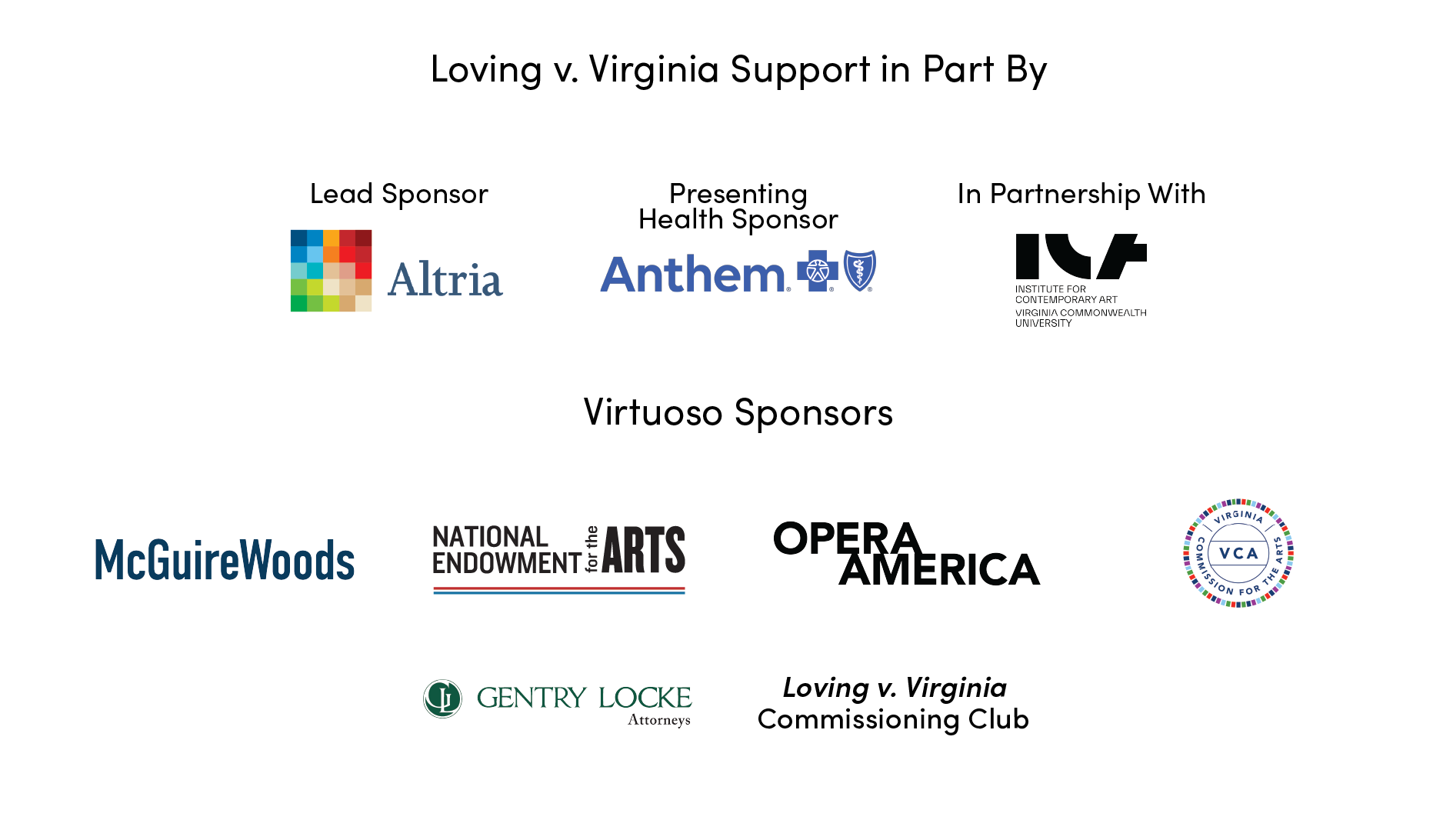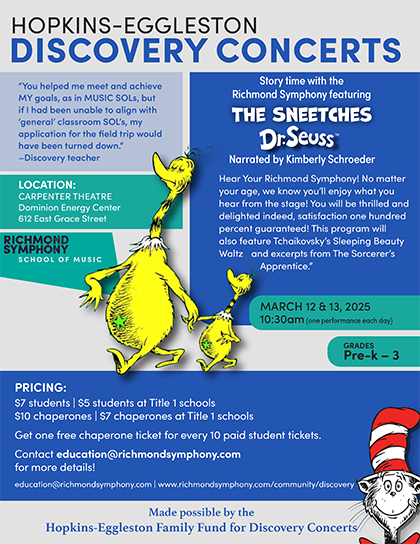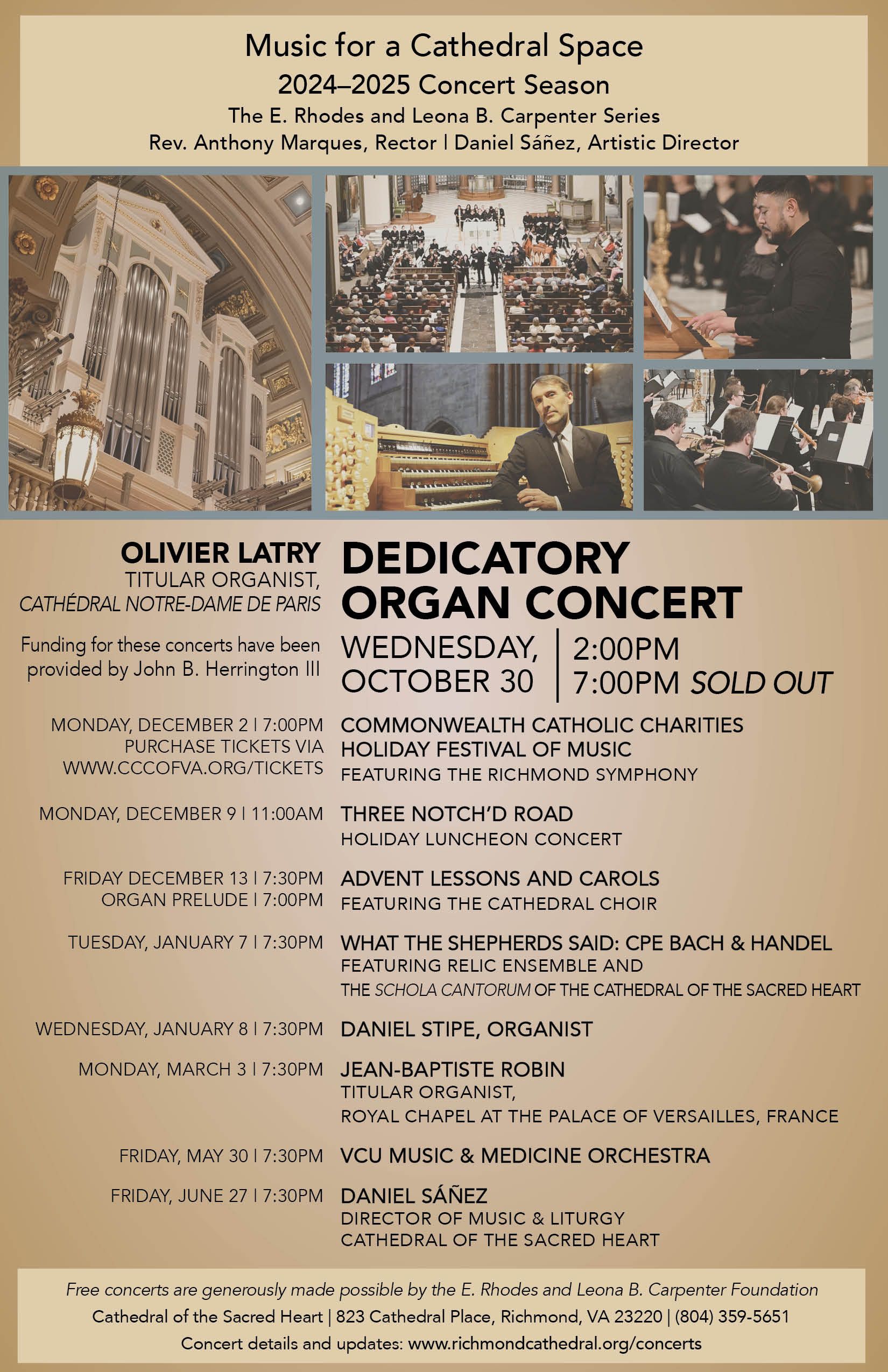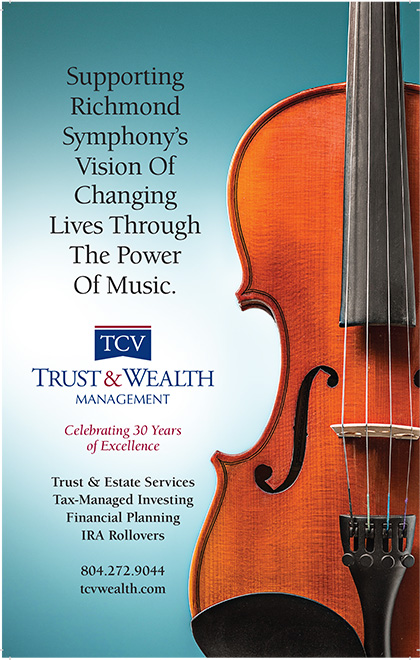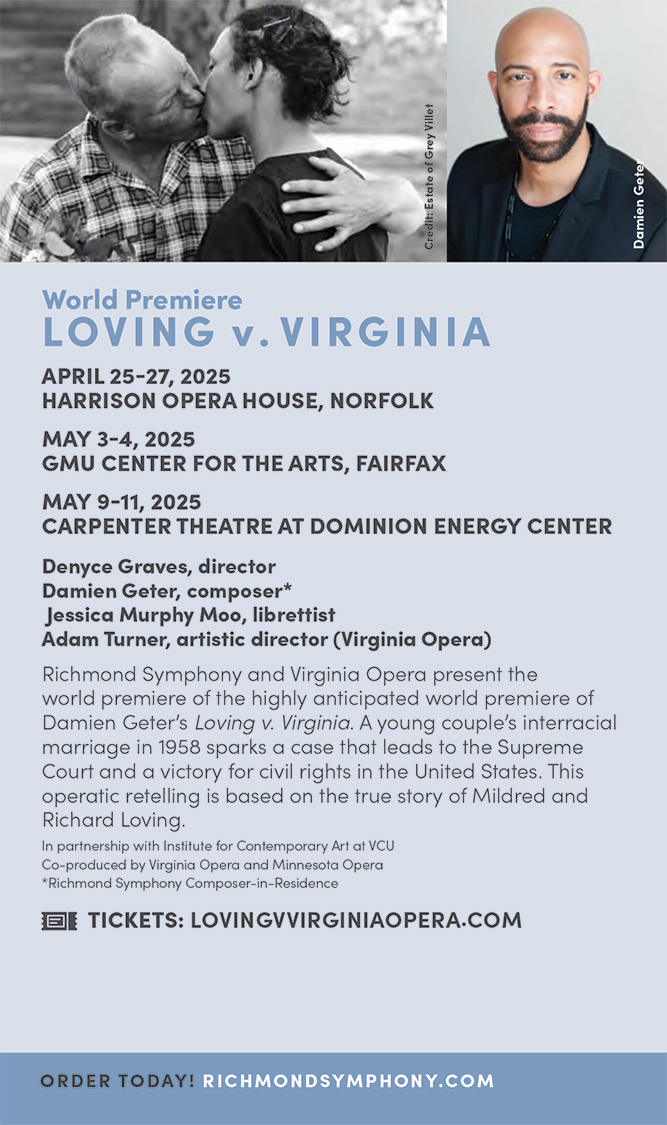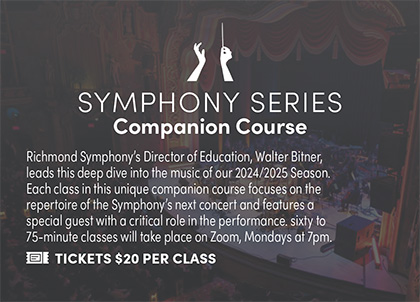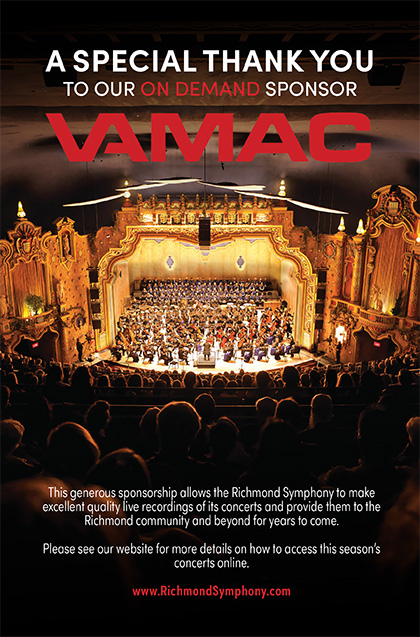
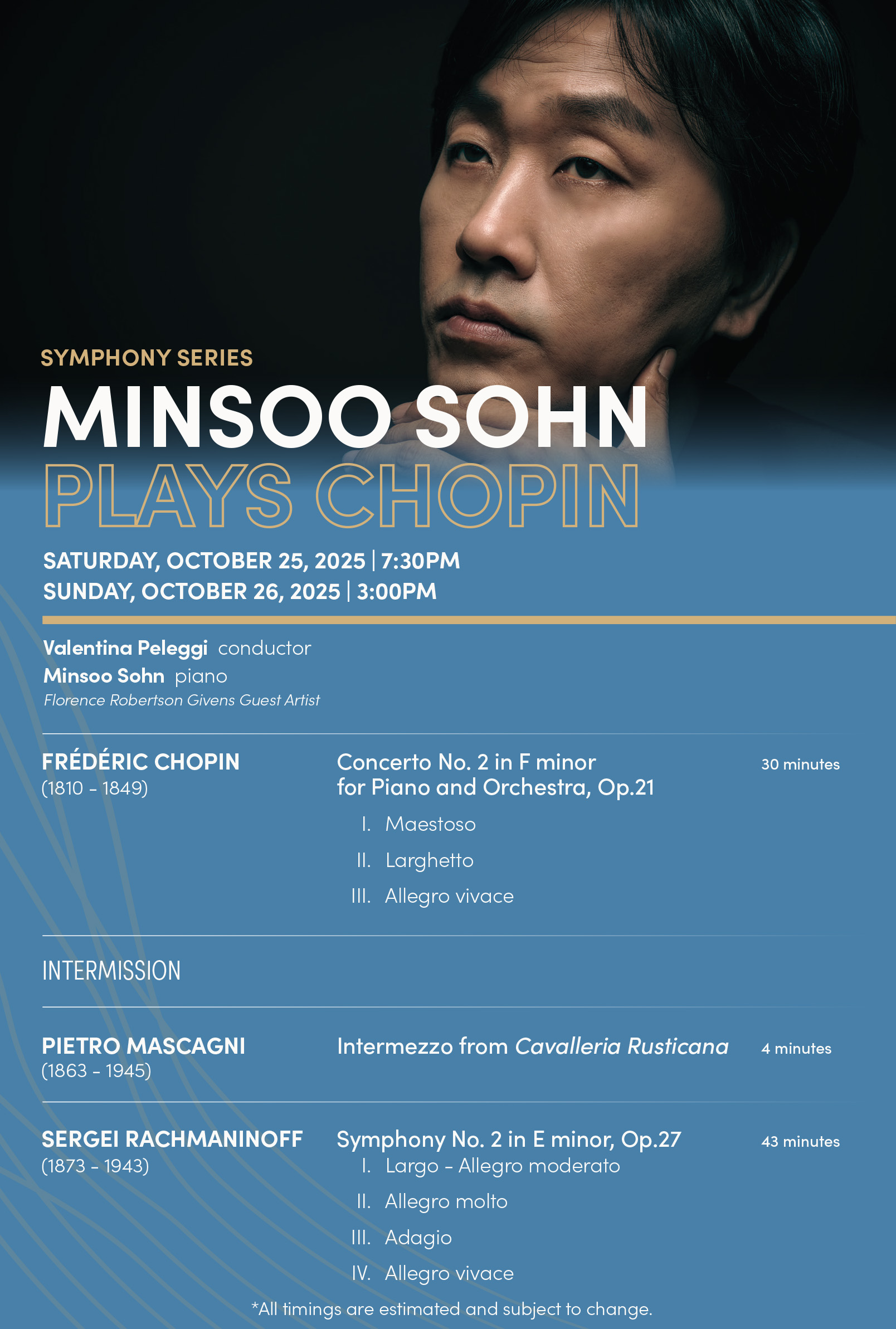
When Music Director Valentina Peleggi considered how to build a program around Chopin’s First Piano Concerto (which is actually his second, chronologically), she saw two possible paths: “To mitigate the sweetness – it’s like a dish – or just go with it,” she says. “And I went with it and decided: let’s dive into the Romantic.” The result is a program that bathes in lush, lyrical writing and sumptuous orchestral colors.
A key reason behind this pairing is what Chopin’s concerto omits: “The orchestra doesn’t have big, lyrical moments. It’s mostly the piano,” Peleggi explains. “So I thought we could offer the orchestra a chance to play these very long, very beautiful, lyrical lines in the second half.” That inspiration led her to Rachmaninoff’s Symphony No. 2 – one of the most sweeping Romantic scores in the repertoire. Where Chopin foregrounds elegant intimacy and decorative brilliance, Rachmaninoff gives us the orchestra in full bloom: bold, emotionally saturated, and unafraid of excess.
Between the two sits a short but poignant interlude: the Intermezzo from Pietro Mascagni’s opera Cavalleria Rusticana. “Mascagni is an homage,” Peleggi adds, “in his 80th anniversary in 2025. So I thought it was nice to have a little moment of late Romantic music from his most famous opera.” Though brief, the piece glows with operatic richness – another voice in this musical conversation across the 19th and early 20th centuries.
Frédéric Chopin: Piano Concerto No. 2 in F minor, Op. 21
Fryderyk Franciszek Chopin – as Frédéric Chopin was known before settling in Paris – had to watch his homeland’s political struggles from afar. In 1830, the year he left Warsaw at age 20 to launch his career abroad, the November Uprising against Russian occupation erupted and was soon brutally crushed. Chopin never returned to Poland, spending the rest of his life in France as a kind of permanent exile. That melancholy undercurrent – of beauty shadowed by loss – haunts even his earliest music.
Before departing, Chopin introduced himself to the Warsaw public as both composer and soloist in two piano concertos written that same year. Though known as his Second Piano Concerto, the work in F minor actually came first. Chopin completed it before writing his so-called First Piano Concerto in E minor – the mix-up comes from their order of publication. These two works represent Chopin’s confident emergence as a young star, and both were designed to showcase his personal brilliance at the keyboard.
Unlike the great classical concertos of Mozart and Beethoven, which balance soloist and orchestra in equal dialogue, Chopin followed a different model – favoring showpiece concertos that leaned toward lighter textures and dazzling virtuosity.
The orchestra opens the first movement with stately grandeur, establishing two contrasting themes: a bold, declamatory idea and a more reflective, lyrical one. But once the piano enters, the story belongs almost entirely to the soloist. Chopin takes these materials and reshapes them in the language of his instrument – reimagining them as poetic musings and decorating them with intricate filigree. From this point on, everything is filtered through the piano’s sensibility.
The heart of the concerto lies in its second movement, marked Larghetto. Here, we encounter the composer as the poet of the piano, offering music of such tenderness and intimacy that it barely feels public at all. Chopin himself admitted the movement was inspired by a real-life infatuation – a shy, unrequited love for the soprano Konstancja Gładkowska, a fellow student at the Warsaw Conservatory.
Drawing on the style known as Italian bel canto opera – valued for its elegant, expressive singing – Chopin writes a long, soaring melody that would be just as at home in an aria by his contemporary Vincenzo Bellini. Chopin translates what might be a vocal line into pianistic terms by making the piano sing with breath-like phrasing and expressive nuance. At one point, he even passes a strand of the melody to the solo bassoon, widening the soundscape.
After such rapture, the finale restores rhythmic vitality. Marked Allegro vivace, it draws on the stylized Polish folk dance known as the mazurka – full of syncopation, offbeat accents, and sudden shifts in mood. A brief, luminous passage in the major key, heralded by the horns, sets up the work’s exuberant conclusion. There’s even a touch of humor in the strings’ col legno playing – a technique of striking the strings with the wood of the bow – as if to suggest a rustic fiddler joining the dance. What began in melancholy and longing ends with triumphant sparkle.
Pietro Mascagni: Intermezzo from Cavalleria Rusticana
Audience regulars who attended last season’s concert performance of Puccini’s Tosca with Valentina Peleggi were plunged into the very heart of Italian verismo – the late-19th-century movement that brought a new kind of “realism” (the meaning of verismo) to the opera stage, presenting emotionally charged, often violent situations with music that amplifies the high-stakes drama and lays bare the characters’ most intense desires and conflicts.
While Puccini became the most enduring voice of verismo, it was Pietro Mascagni who launched the verismo movement with his sensational 1890 debut opera Cavalleria Rusticana. The two composers were close contemporaries – friends and rivals from their student days in Milan. Where Puccini developed a more complex dramatic style over time, Mascagni’s breakthrough captured verismo at its rawest: a compact tale of jealousy, betrayal, and revenge set in a Sicilian village on Easter morning.
The title Cavalleria Rusticana, usually translated as “Rustic Chivalry,” refers – ironically – to a traditional Sicilian code of honor that dictates behavior in matters of love and betrayal. In the opera, this notion of “chivalry” is far from medieval knighthood; it becomes a brutally destructive force. The opera revolves around the soldier Turiddu. After returning home from war, he rekindles an affair with his now-married former lover, setting off a fatal chain of jealousy and revenge.
The brief Intermezzo offers a rare moment of calm and emotional reprieve between scenes. Scored for strings and harp, its quiet lyricism provides a poignant contrast to the surrounding drama– and has become one of Mascagni’s most cherished melodies. The gently rocking triple meter evokes pastoral serenity, though tinged with melancholy. Fans of The Godfather series will recall that the Intermezzo plays an important role at the climax of Part III.
Sergei Rachmaninoff: Symphony No. 2 in E minor, Op. 27
We are fortunate to have Sergei Rachmaninoff’s Second Symphony – along with the rest of his mature works – since he nearly gave up composing after the catastrophic premiere of his First Symphony in 1897. That performance, marred by poor preparation and widely blamed on the drunken incompetence of its conductor, Alexander Glazunov, devastated Rachmaninoff’s confidence and plunged him into a prolonged depression.
A breakthrough came through the patient efforts of his therapist, Dr. Nikolai Dahl, whose treatment included hypnosis and daily affirmations. The result was the Second Piano Concerto of 1901 – still Rachmaninoff’s most popular work. But he remained wary of writing another symphony. It wasn’t until 1906, when he relocated to Dresden to escape the demands of public life in Moscow, that Rachmaninoff resumed serious composition. The Second Symphony, begun in late 1906 and completed the following year, was first performed in 1908 in St. Petersburg, conducted by the composer himself – and was met with great acclaim.
Today it is recognized as one of the great Romantic symphonies of the 20th century. But for decades, the piece was often performed in heavily cut versions – slimming down its hour-long structure to suit changing tastes. Fortunately, most modern performances restore the score to its full grandeur, as Rachmaninoff intended.
The Second Symphony opens with a slow introduction – a brooding, chant-like figure in the low strings that serves as a kind of generative cell for the entire work. This stepwise motto theme, reminiscent of Orthodox liturgical chant, recurs in various guises throughout the symphony. Its solemnity quickly gives way to a richly lyrical Allegro, where sweeping violin lines and a warmly contoured second theme unfold in Rachmaninoff’s trademark style. Echoes of Tchaikovsky, especially the Pathétique Symphony, abound – but so do more modern touches, including bold harmonic shifts and complex counterpoint.
The second movement, a scherzo in all but name, is rhythmically propulsive and filled with energetic bite. A recurring rhythmic motif hints at Rachmaninoff’s lifelong fascination with the medieval Dies Irae chant evoking the Last Judgment, often used in his music to evoke mortality. Here it’s more subtle, woven into the texture rather than declared outright.
The Adagio is the emotional heart of the symphony – one of Rachmaninoff’s most sublime slow movements. A soaring violin theme, noble and impassioned, begins the movement, but it’s the solo clarinet that steals the show with an achingly beautiful melody. These ideas recur, intertwine, and evolve in a rhapsodic unfolding that never loses its sense of lyrical poise. As in the slow movement of his Second Piano Concerto, Rachmaninoff demonstrates an unerring gift for long-form melodic architecture.
The finale bursts forth with extroverted energy. Its buoyant opening theme contrasts with the darker shadows of the earlier movements, and the music barrels forward with exuberance. The E minor key of the opening gives way at last to a triumphant E major, reinforcing the work’s hard-won optimism. In the final pages, Rachmaninoff interlaces themes from earlier movements, building to a radiant climax that seems to ring with the sound of pealing bells.
Program notes (c)2025 Thomas May
1st VIOLIN
Daisuke Yamamoto,
CONCERTMASTER
Tom & Elizabeth
Allen Chair
Adrian Pintea,
ASSOCIATE PRINCIPAL 1ST VIOLIN
Catherine Cary
Alison Hall
Anna Rogers
Susy Yim
Stacy Matthews
Susan Spafford
Jill Foster
Claudia Chudacoff
Treesa Gold
Laura Frazelle
2nd VIOLIN
Jeannette Jang,
ASSOCIATE PRINCIPAL
2ND VIOLIN
The Bob & Nancy
Hill Chair
Alana Carithers
Anna Bishop
Timothy Judd
Emily Monroe
Audrey Gray
Matt Richardson
Alyssa Evans
Violaine Michel
Satoko Fukasawa
VIOLA
Rebecca Benjamin
PRINCIPAL
The Mary Anne
Rennolds Chair
Hyo Joo Uh,
ASSOCIATE PRINCIPAL
Zsuzsanna Emodi
Stephen Schmidt
Jocelyn Smith
Johanna Beaver
Liz O’Hara
Sandra VandeGeijn
CELLO
Neal Cary,
PRINCIPAL
Jason McComb,
ASSOCIATE PRINCIPAL
Richmond Symphony
League Chair
Peter Greydanus
Schuyler Slack
Kenneth & Bettie
Christopher Perry
Foundation Chair
Ryan Lannan
Barbara Gaden
Adrienne Gifford-Yang
Dana McComb
BASS
Lee Philip
ACTING PRINCIPAL
Rumano Solano,
ASSOCIATE PRINCIPAL
Kelly Ali
Peter Spaar
Morgan Daly
Jose Saavedra
FLUTE
Mary Boodell
PRINCIPAL
Jennifer Debiec Lawson
ASSOCIATE PRINCIPAL
Catherine Broyles
OBOE
Victoria Chung,
PRINCIPAL
Kara Poling,
ASSOCIATE PRINCIPAL
Thomas Frieddle
CLARINET
David Lemelin,
PRINCIPAL
Eddie Sundra
ASSOCIATE PRINCIPAL
Jennifer Tsheulin
BASSOON
Thomas Schneider
PRINCIPAL
Corinne Crowley
HORN
Dominic Rotella,
PRINCIPAL
Devin Gossett
The Luzi Wheeler
Leisinger & George
Wheeler Chair
Erin Lano
ASSOCIATE PRINCIPAL
Cody Halquist
TRUMPET
Brian Strawley
ACTING PRINCIPAL
Andrew Moreschi
Daniel Egan
TROMBONE
Han Yun (Jonathan) Liang
ACTING PRINCIPAL
Scott Winger
Scott Cochran
TUBA
Conrad Shaw,
PRINCIPAL
TIMPANI
James Jacobson,
PRINCIPAL
PERCUSSION
Clifton Hardison,
PRINCIPAL
Robert Jenkins
David Foster
Don Johns
HARP
Anastasia Jellison


